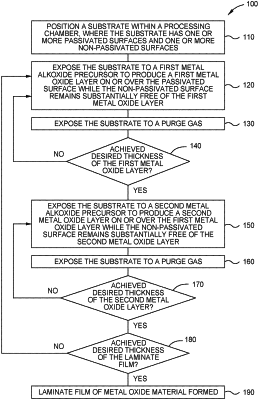| CPC C23C 16/405 (2013.01) [C23C 16/45523 (2013.01); C23C 28/04 (2013.01)] | 20 Claims |

|
1. A method of forming a metal oxide material, comprising:
positioning a substrate within a processing chamber, wherein the substrate comprises a passivated surface and a non-passivated surface, and wherein the non-passivated surface is terminated with hydride groups, hydroxide groups, or a combination thereof;
exposing the substrate to a first metal alkoxide precursor to produce a first metal oxide layer on or over the non-passivated surface while the passivated surface remains at least substantially free of the first metal oxide layer, wherein the first metal alkoxide precursor is thermally decomposed to produce the first metal oxide layer;
exposing the substrate to a second metal alkoxide precursor to produce a second metal oxide layer on the first metal oxide layer while the passivated surface remains at least substantially free of the second metal oxide layer, wherein the second metal alkoxide precursor is thermally decomposed to produce the second metal oxide layer, and wherein the first metal alkoxide precursor and the second metal alkoxide precursor have different metals; and
sequentially repeating exposing the substrate to the first metal alkoxide precursor and the second metal alkoxide precursor to produce a laminate film comprising alternating layers of the first and second metal oxide layers, wherein the laminate film comprises about 5 pairs to about 200 pairs of the first and second metal oxide layers.
|